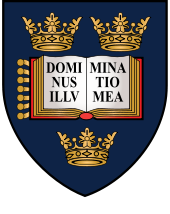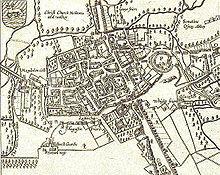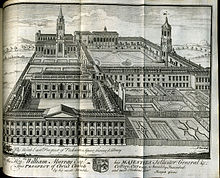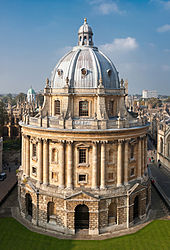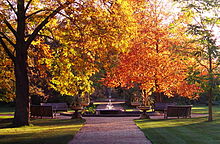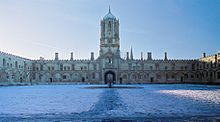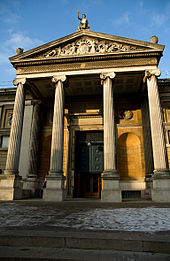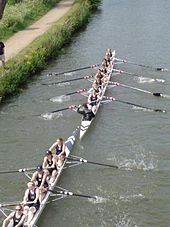
University of Oxford
Did you know...
This Wikipedia selection is available offline from SOS Children for distribution in the developing world. Click here for more information on SOS Children.
Coordinates: 51.7611°N 1.2534°W
| University of Oxford | |
|---|---|
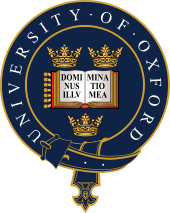 University of Oxford seal |
|
| Latin: Universitas Oxoniensis | |
| Motto | Dominus Illuminatio Mea (Latin) |
| Motto in English | The Lord is my Light |
| Established | Unknown, teaching existed since 1096 |
| Endowment | £3.316 billion (inc. colleges) |
| Chancellor | The Rt. Hon. Lord Patten of Barnes |
| Vice-Chancellor | Andrew Hamilton |
| Students | 21,535 |
| Undergraduates | 11,723 |
| Postgraduates | 9,327 |
| Other students | 461 |
| Location | Oxford, England, U.K. |
| Colours | Oxford Blue |
| Athletics | The Sporting Blue |
| Affiliations | IARU Russell Group Coimbra Group Europaeum EUA G5 LERU |
| Website | ox.ac.uk |
 |
|
The University of Oxford (informally Oxford University or Oxford, derived from the Latin, Universitas Oxoniensis) is a university located in Oxford, England, United Kingdom. It is the oldest university in the English-speaking world, and the second- oldest surviving university in the world. Although its exact date of foundation is unclear, there is evidence of teaching as far back as 1096. The University grew rapidly from 1167 when Henry II banned English students from attending the University of Paris. In post-nominals the University of Oxford is commonly abbreviated as Oxon., from the Latin Universitas Oxoniensis, although Oxf is now used in official university publications, despite widespread and acknowledged criticism .
After disputes between students and Oxford townsfolk in 1209, some academics fled north-east to Cambridge, where they established what became the University of Cambridge. The two ancient English universities have many common features and are often jointly referred to as Oxbridge. In addition to their cultural and practical associations, as a historic part of British society, they have a long history of rivalry with each other.
Most undergraduate teaching at Oxford is organised around weekly tutorials at self-governing colleges and halls, supported by classes, lectures and laboratory work organised by University faculties and departments. , . For more than a century, it has served as the home of the Rhodes Scholarship, which brings students from a number of countries to study at Oxford as postgraduates or for a second bachelor's degree.
History
Founding
The University of Oxford has no known foundation date. Teaching at Oxford existed in some form in 1096, but it is unclear at what point a university came into being.
The expulsion of foreigners from the University of Paris in 1167 caused many English scholars to return from France and settle in Oxford. The historian Gerald of Wales lectured to such scholars in 1188, and the first known foreign scholar, Emo of Friesland, arrived in 1190. The head of the University was named a chancellor from at least 1201, and the masters were recognised as a universitas or corporation in 1231. The students associated together on the basis of geographical origins, into two " nations", representing the North (including the Scots) and the South (including the Irish and the Welsh). In later centuries, geographical origins continued to influence many students' affiliations when membership of a college or hall became customary in Oxford. Members of many religious orders, including Dominicans, Franciscans, Carmelites, and Augustinians, settled in Oxford in the mid-13th century, gained influence, and maintained houses for students. At about the same time, private benefactors established colleges to serve as self-contained scholarly communities. Among the earliest such founders were William of Durham, who in 1249 endowed University College, and John Balliol, father of a future King of Scots: Balliol College bears his name. Another founder, Walter de Merton, a chancellor of England and afterwards Bishop of Rochester, devised a series of regulations for college life; Merton College thereby became the model for such establishments at Oxford, as well as at the University of Cambridge. Thereafter, an increasing number of students forsook living in halls and religious houses in favour of living in colleges.
In 1333-4 an attempt by some dissatisfied Oxford scholars to found a new university at Stamford, Lincolnshire was blocked by the universities of Oxford and Cambridge petitioning king Edward III. Thereafter until the 1820s no new universities were allowed to start in England even in London, and Oxford and Cambridge had a monopoly unusual in western European countries.
Renaissance period
The new learning of the Renaissance greatly influenced Oxford from the late 15th century onwards. Among university scholars of the period were William Grocyn, who contributed to the revival of Greek language studies, and John Colet, the noted biblical scholar. With the Reformation and the breaking of ties with the Roman Catholic Church, Recusant scholars from Oxford fled to continental Europe, settling especially at the University of Douai. The method of teaching at Oxford was transformed from the medieval Scholastic method to Renaissance education, although institutions associated with the university suffered losses of land and revenues. In 1636, Chancellor William Laud, archbishop of Canterbury, codified the university's statutes; these to a large extent remained its governing regulations until the mid-19th century. Laud was also responsible for the granting of a charter securing privileges for the University Press, and he made significant contributions to the Bodleian Library, the main library of the university. From the inception of the Church of England until 1866 membership of the church was a requirement to receive the BA degree from Oxford, and "dissenters" were only permitted to receive the MA in 1871.
The university was a centre of the Royalist party during the English Civil War (1642–1649), while the town favoured the opposing Parliamentarian cause. From the mid-18th century onwards, however, the University of Oxford took little part in political conflicts.
Modern period
The mid nineteenth century saw the impact of the Oxford Movement (1833–1845), led among others by the future Cardinal Newman. The influence of the reformed model of German university reached Oxford via key scholars such as Edward Bouverie Pusey, Benjamin Jowett and Max Müller.
The system of separate honour schools for different subjects began in 1802, with Mathematics and Literae Humaniores. Schools for Natural Sciences and Law, and Modern History were added in 1853. By 1872 the latter was split into Jurisprudence and Modern History, and Theology was the sixth honour school. In addition to these BA Honours degrees, the post-graduate Bachelor of Civil Law (BCL) was (and still is) offered.
Administrative reforms during the 19th century included the replacement of oral examinations with written entrance tests, greater tolerance for religious dissent, and the establishment of four women's colleges. Twentieth century Privy Council decisions (such as the abolition of compulsory daily worship, dissociation of the Regius professorship of Hebrew from clerical status, diversion of theological bequests to colleges to other purposes) loosened the link with traditional belief and practice. Although the University's emphasis traditionally had been on classical knowledge, its curriculum expanded in the course of the 19th century to encompass scientific and medical studies. Knowledge of Ancient Greek was required for admission until 1920, and Latin until 1960.
The mid twentieth century saw many distinguished continental scholars, displaced by Nazism and Communism, relocating to Oxford.
The list of distinguished scholars at the University of Oxford is long and includes many who have made major contributions to British politics, the sciences, medicine, and literature. More than forty Nobel laureates and more than fifty world leaders have been affiliated with the University of Oxford.
Women's education
The University passed a Statute in 1875 allowing its delegates to create examinations for women at roughly undergraduate level. The first four women's colleges were established thanks to the activism of the Association for Promoting the Higher Education of Women (AEW). Lady Margaret Hall (1878) was followed by Somerville College in 1879; the first 21 students from Somerville and Lady Margaret Hall attended lectures in rooms above an Oxford baker's shop. The first two colleges for women were followed by St Hugh's (1886), St Hilda's (1893) and St Anne's College (1952). Oxford was long considered a bastion of male privilege, and it was not until 7 October 1920 that women became eligible for admission as full members of the university and were given the right to take degrees. In 1927 the University's dons created a quota that limited the number of female students to a quarter that of men, a ruling which was not abolished until 1957. However, before the 1970s all Oxford colleges were for men or women only, so that the number of women was effectively limited by the capacity of the women's colleges to admit students. It was not until 1959 that the women's colleges were given full collegiate status.
In 1974 Brasenose, Jesus, Wadham, Hertford and St Catherine's became the first previously all-male colleges to admit women. In 2008 the last single sex college, St Hilda's, admitted its first men, meaning all colleges are now co-residential. By 1988, 40% of undergraduates at Oxford were female; the ratio is now about 48:52 in men's favour.
The detective novel Gaudy Night by Dorothy Sayers – herself one of the first women to gain an academic degree from Oxford – takes place in a (fictional) women's college at Oxford, and the issue of women's education is central to its plot.
Buildings, collections and facilities
Main Sites
The University is a 'city university' in that it does not have a main campus. Instead colleges, departments, accommodation, and other facilities are scattered throughout the city centre. The Science Area, in which most science departments are located, is the area that bears closest resemblance to a campus. The ten acre Radcliffe Observatory Quarter in the northwest of the city is currently under development. However the larger colleges' sites are of similar size to these areas.
Iconic university buildings include the Sheldonian Theatre used for music concerts, lectures and university ceremonies and Examination Schools where examinations and some lectures take place. The University Church of St Mary the Virgin was used for university ceremonies before the construction of the Sheldonian. Christ Church Cathedral uniquely serves as both a college chapel and as a cathedral.
Libraries
The University maintains the largest university library system in the UK and with over 11 million volumes housed on 120 miles (190 km) of shelving the Bodleian group is the second-largest library in the UK, after the British Library. The Bodleian is a legal deposit library, which means that it is entitled to request a free copy of every book published in the UK. As such, its collection is growing at a rate of over three miles (five kilometres) of shelving every year.
The buildings referred to as the University's main research library The Bodleian consist of the original Bodleian Library in the Old Schools Quadrangle, founded by Sir Thomas Bodley in 1598 and opened in 1602, the Radcliffe Camera, the Clarendon Building, and the New Bodleian Building. A tunnel underneath Broad Street connects these buildings, with the Gladstone Link connecting the Old Bodleian and Radcliffe Camera opening to readers in 2011.
The Bodleian Libraries group was formed in 2000, bringing the Bodleian Library and some of the subject libraries together. It now comprises 28 libraries, a number of which have been created by bringing previously separate collections together, including the Sackler Library, Social Science Library and Radcliffe Science Library. Another major product of this collaboration has been a joint integrated library system, OLIS (Oxford Libraries Information System), and its public interface, SOLO (Search Oxford Libraries Online), which provides an electronic catalogue covering all member libraries, as well as the libraries of individual colleges and other faculty libraries, which are not members of the group but do share cataloguing information.
A new book depository opened in South Marston, Swindon in October 2010, and current building projects include the remodelling of the New Bodleian building, which will be renamed the Weston Library when it reopens in 2014-15. The renovation is designed to better showcase the library’s various treasures (which include a Shakespeare First Folio and a Gutenberg Bible) as well as temporary exhibitions.
The Bodleian engaged in a mass-digitisation project with Google in 2004.
Museums
Oxford maintains a number of museums and galleries, open for free to the public. The Ashmolean Museum, founded in 1683, is the oldest museum in the UK, and the oldest university museum in the world. It holds significant collections of art and archaeology, including works by Michelangelo, Leonardo da Vinci, Turner, and Picasso, as well as treasures such as the Scorpion Macehead, the Parian Marble and the Alfred Jewel. It also contains " The Messiah", a pristine Stradivarius violin, regarded by some as one of the finest examples in existence. The Ashmolean reopened in November 2009, after a £49m redevelopment, doubling the display space as well as providing new facilities.
The Museum of Natural History holds the University’s zoological, entomological and geological specimens. It is housed in a large neo-Gothic building on Parks Road, in the University’s Science Area. Among its collection are the skeletons of a Tyrannosaurus rex and triceratops, and the most complete remains of a dodo found anywhere in the world. It also hosts the Simonyi Professorship of the Public Understanding of Science, currently held by Marcus du Sautoy.
Adjoining the Museum of Natural History is the Pitt Rivers Museum, founded in 1884, which displays the University’s archaeological and anthropological collections, currently holding over 500,000 items. It recently built a new research annexe; its staff have been involved with the teaching of anthropology at Oxford since its foundation, when as part of his donation General Augustus Pitt Rivers stipulated that the University establish a lectureship in anthropology.
The Museum of the History of Science is housed on Broad St in the world’s oldest-surviving purpose-built museum building. It contains 15,000 artefacts, from antiquity to the 20th century, representing almost all aspects of the history of science. In the Faculty of Music on St Aldate's is the Bate Collection of Musical Instruments, a collection mostly of instruments from Western classical music, from the medieval period onwards. Christ Church Picture Gallery holds a collection of over 200 old master paintings.
Parks
The University Parks are a 70 acre parkland area in the northeast of city. It is open free of charge to the public during daylight hours. As well as providing beautiful gardens and rare and exotic plants, the parks contains numerous sports fields, used for official and unofficial fixtures.
The Botanic Garden on the High Street is the oldest botanic garden in the UK and the third-oldest scientific garden in the world. It contains over 8,000 different plant species on 1.8 4½ acres. It is one of the most diverse yet compact collections of plants in the world and includes representatives from over 90% of the higher plant families. The Harcourt Arboretum is a 130 acre site six miles south of the city that includes native woodland and 67 acres of meadow. The 1000 acre Wytham Woods are owned by the University and used or research in zoology and climate change.
There are also various collegiate owned open spaces open to the public, most notably Christ Church Meadow.
Organisation
- See: Departments of the University of Oxford
As a collegiate university, Oxford's structure can be confusing to those unfamiliar with it. The university is a federation: it comprises over forty self-governing colleges and halls, along with a central administration headed by the Vice-Chancellor. The academic departments are located centrally within this structure; they are not affiliated with any particular college. Departments provide facilities for teaching and research, determine the syllabi and guidelines for the teaching of students, perform research, and deliver lectures and seminars. Colleges arrange the tutorial teaching for their undergraduates. The members of an academic department are spread around many colleges; though certain colleges do have subject alignments (e.g. Nuffield College as a centre for the social sciences), these are exceptions, and most colleges will have a broad mix of academics and students from a diverse range of subjects. Facilities such as libraries are provided on all these levels: by the central university (the Bodleian), by the departments (individual departmental libraries, such as the English Faculty Library), and by colleges (each of which maintains a multi-discipline library for the use of its members).
Affiliations
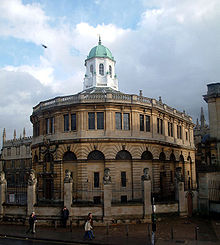
Oxford is a member of the Russell Group of research-led British universities, the Coimbra Group, the G5, the League of European Research Universities, and the International Alliance of Research Universities. It is also a core member of the Europaeum and forms part of the " golden triangle" of British universities.
Central governance
The university's formal head is the Chancellor, currently Lord Patten of Barnes, though as at most British universities, the Chancellor is a titular figure, and is not involved with the day-to-day running of the university. The Chancellor is elected by the members of Convocation, a body comprising all graduates of the university, and holds office until death.
The Vice-Chancellor, currently Andrew Hamilton, is the de facto head of the University. Five Pro-Vice-Chancellors have specific responsibilities for Education; Research; Planning and Resources; Development and External Affairs; and Personnel and Equal Opportunities. The University Council is the executive policy-forming body, which consists of the Vice-Chancellor as well as heads of departments and other members elected by Congregation, in addition to observers from the Student Union. Congregation, the "parliament of the dons", comprises over 3,700 members of the University’s academic and administrative staff, and has ultimate responsibility for legislative matters: it discusses and pronounces on policies proposed by the University Council. Only Oxford and Cambridge (which is similarly structured) have this democratic form of governance.
Two university proctors, who are elected annually on a rotating basis from two of the colleges, are the internal ombudsmen who make sure that the university and its members adhere to its statutes. This role incorporates student welfare and discipline, as well as oversight of the university's proceedings. The University Professors are collectively referred to as the Statutory Professors of the University of Oxford. They are particularly influential in the running of the university's graduate programmes. Examples of Statutory Professors are the Chichele Professorships and the Drummond Professor of Political Economy. The various academic faculties, departments, and institutes are organised into four divisions, each with its own Head and elected board. They are the Humanities Division; the Social Sciences Division; the Mathematical, Physical and Life Sciences Division; and the Medical Sciences Division.
The University of Oxford is a "public university": it receives a large amount of public money from the government, but it is a "private university" in the sense that it is entirely self-governing and could choose to become entirely private by rejecting public funds.
Colleges
To be a member of the university, all students, and most academic staff, must also be a member of a college or hall. There are thirty-eight colleges of the University of Oxford and six Permanent Private Halls, each controlling its membership and with its own internal structure and activities. Not all colleges offer all courses, but they generally cover a broad range of subjects.
The colleges are:
- All Souls
- Balliol
- Brasenose
- Christ Church
- Corpus Christi
- Exeter
- Green Templeton
- Harris Manchester
- Hertford
- Jesus
- Keble
- Kellogg
- Lady Margaret Hall
- Linacre
- Lincoln
- Magdalen
- Mansfield
- Merton
- New
- Nuffield
- Oriel
- Pembroke
- Queen's
- St Anne's
- St Antony's
- St Catherine's
- St Cross
- St Edmund Hall
- St Hilda's
- St Hugh's
- St John's
- St Peter's
- Somerville
- Trinity
- University
- Wadham
- Wolfson
- Worcester
The Permanent Private Halls were founded by different Christian denominations. One difference between a college and a PPH is that whereas the former are governed by the fellows of the college, the governance of a PPH resides, at least in part, with the corresponding Christian denomination. The six current PPHs are:
- Blackfriars Hall
- Campion Hall
- Regent's Park
- St Benet's Hall
- St Stephen's House
- Wycliffe Hall
The PPHs and colleges join together as the Conference of Colleges, which represents the common concerns of the several colleges of the University, and to discuss policy and to deal with the central University administration. The Conference of Colleges was established as a recommendation of the Franks Commission in 1965.
Teaching members of the colleges (fellows and tutors) are collectively and familiarly known as dons, although the term is rarely used by the University itself. In addition to residential and dining facilities, the colleges provide social, cultural, and recreational activities for their members. Colleges have responsibility for admitting undergraduates and organising their tuition; for graduates, this responsibility falls upon the departments. There is no common title for the heads of colleges, the names used include warden, provost, principal, president, rector, master and dean.
Finances
In 2005/06 the University had an income of £608m, and the colleges £237m (of which £41m is a flow-through from the University). For the University, key sources were HEFCE (£166m) and research grants (£213m). For the colleges, the largest single source was endowments and interest (£82m) and residential charges (£47m). While the University has the larger operating budget, the colleges have a far larger aggregate endowment, at around £2.7bn compared to the University's £900m. The Central University's endowment, along with that of many of the colleges, is managed by the University's wholly owned endowment management office, Oxford University Endowment Management, formed in 2007.
The University also launched a fundraising campaign in May 2008, called Oxford Thinking – The Campaign for the University of Oxford. With a minimum goal of £1.25 billion, the Campaign is looking to support three areas: academic posts and programmes, student support, and buildings and infrastructure.
Academic profile
Teaching and degrees
Undergraduate teaching is centred on the tutorial, where 1–4 students spend an hour with an academic discussing their week’s work, usually an essay (humanities, most social sciences, some mathematical, physical, and life sciences) or problem sheet (most mathematical, physical, and life sciences, and some social sciences). Students usually have one or two tutorials a week, and can be taught by academics at any other college—not just their own—as expertise and personnel require. These tutorials are complemented by lectures, classes and seminars, which are organised on a departmental basis. Graduate students undertaking taught degrees are usually instructed through classes and seminars, though there is more focus upon individual research.
The university itself is responsible for conducting examinations and conferring degrees. The passing of two sets of examinations is a prerequisite for a first degree. The first set of examinations, called either Honour Moderations ("Mods" and "Honour Mods") or Preliminary Examinations ("Prelims"), are usually held at the end of the first year (after two terms for those studying Law, Theology, Philosophy and Theology, Experimental Psychology or Psychology, Philosophy and Physiology or after five terms in the case of Classics). The second set of examinations, the Final Honour School ("Finals"), is held at the end of the undergraduate course (for humanities and most social sciences) or at the end of each successive year of the course after the first (most mathematical, physical and life sciences, and some social sciences). Successful candidates receive first-, upper or lower second-, or third-class honours, or simply a "pass" without honours, based on their performance in Finals. An upper second is the most usual result, and a first is generally prerequisite for graduate study. A "double first" reflects first class results in both Honour Mods. and Finals. Research degrees at the master's and doctoral level are conferred in all subjects studied at graduate level at the university. As a matter of tradition, bachelor's degree graduates are eligible, after seven years from matriculation (formal induction of students into the university) and without additional study, to purchase for a nominal fee an upgrade of their bachelor's degree to an "MA" or Master of Arts. All MAs were members of Convocation and until 1913 all resident members of Convocation were members of Congregation. MAs, as members of Convocation, elected the Chancellor and Professor of Poetry, but recently Convocation has been widened to consist of all graduates.
Academic year
The academic year is divided into three terms. Michaelmas Term lasts from October to December; Hilary Term from January to March; and Trinity Term from April to June. Within each of these terms, Council determines an eight-week period called Full Term, during which undergraduate teaching takes place. These teaching terms are shorter than those of many other British universities, and the total duration of Full Terms amounts to less than half the year. However undergraduates are also expected to do some academic work during the three holidays (known as the Christmas, Easter and Long Vacations).
Internally at least, the weeks in the term are often referred to by the time elapsed since the start of each Full Term: thus the first week of any Full Term is called "1st week" and the last is "8th week". The numbering of the weeks continues up to the end of the term, and begins again with negative numbering from the beginning of the succeeding term, through "minus first week" and "noughth week", which precede "1st week". These weeks begin on a Sunday. Undergraduates must be in residence from Thursday of 0th week.
Undergraduate admissions
Age
In line with the other UK universities, almost all students are age 17 or over, and the majority commence undergraduate courses at 18 or 19. However there is no upper or lower limit on the age of those admitted. There is a college, Harris Manchester, that caters only for students aged 21 or over.
Historically, it was common for boys to become members of the university between the ages of 14 and 19. Jeremy Bentham matriculated in 1761 at the age of 13, which was unusually young. Much younger people are still occasionally admitted to the university if they are of the required standard, for example Ruth Lawrence matriculated age 12 in 1983, as did Sufiah Yusof aged 13 in 1997.
Procedure
Prospective students apply through the UCAS application system, in common with most British universities, but (along with applicants for Medicine, Dentistry and Cambridge applicants) must observe an earlier deadline of 15 October. To allow a more personalised judgement of students, who might otherwise apply for both, undergraduate applicants are not permitted to apply to both Oxford and Cambridge in the same year. The only exceptions are applicants for Organ Scholarships and those applying to read for a second undergraduate degree. Students from all backgrounds are encouraged to apply, with "contextual data" (factors that may have influenced prior exam performance) taken into account during the admission procedure. The university believes that there are many potential students from less well off backgrounds whom the university cannot admit simply because they do not apply.
Most applicants choose to apply to one of the individual colleges, which work with each other to ensure that the best students gain a place somewhere at the University whichever college they choose. Shortlisting is based on achieved and predicted exam results; school references and, in some subjects, written admission tests or candidate-submitted written work. Approximately 60% of applicants are shortlisted, although this varies by subject. If a large number of shortlisted applicants for a subject choose one college, then students who named that college may be reallocated randomly to under-subscribed colleges for the subject. The colleges then invite shortlisted candidates for interview, where they are provided with food and accommodation for around three days in December. Most applicants will be individually interviewed by academics at more than one college. Students from outside Europe can be interviewed remotely, for example over the Internet. In 2007 the colleges, faculties and departments published a "common framework" outlining the principles and procedures they observe.
Offers are sent out shortly before Christmas (exceptionally, in early January for the 2012-13 admissions round), with an offer usually being from a specific college. One in four successful candidates receive offers from a college that they did not apply to. Some courses may make "open offers" to some candidates, who are not assigned to a particular college until A Level results day in August.
Access
The University states that its admissions policies avoid bias against candidates of certain socio-economic or educational backgrounds. However, the fairness of Oxford admissions has attracted public controversy through episodes such as the Laura Spence Affair in 2000. Gaining places at Oxford and Cambridge remains a central focus for many private and selective state schools - much more so than most state schools - and the fact that the social make-up of undergraduates at the University differs substantially from the social make-up of society at large remains controversial. Veiled accusations of racism regarding the 2009 intake were rebutted on the grounds that ethnic minority applicants apply disproportionately more to the most competitive courses, and that black candidates had lower A-level scores nationally. However further analysis of entrance figures for 2010 and 2011 were reported to have revealed what was termed an "institutional bias" in favour of white candidates - it was reported that ethnic minority candidates had significantly lower success rates in individual subjects even when they had the same grades as white candidates. In medicine it was shown, for instance, ethnic minority applicants who went on to score three A* grades at A level were almost half as likely to gain admission as white applicants with similar grades In 2007, the University refined its admissions procedure to take into account the academic performance of its applicants' schools.
Students who apply from state schools and colleges have an acceptance rate broadly comparable to those from independent schools (19% and 24% of applicants accepted respectively, 2010). More than half of applications come from the state sector, and the University of Oxford funds many initiatives to attract applicants from this sector, including the UNIQ Summer Schools, Oxford Young Ambassadors, Target Schools, and the FE Access Initiative. Regarding the UNIQ Summer School, of all the UNIQ students who went on to make applications in autumn 2010 to enter the University in 2011/12, 39 per cent ended up with places. The overall success rate for Oxford applicants is around 20 per cent. Most colleges also run their own access schemes and initiatives.
The Oxford Admissions Study was a research project setup to investigate access issues, in which data was collected on 2,000 students who applied to the University in 2002, including exam results from the universities they went on to attend. A number of reports were published based on this data. It was found that, if anything, admissions tutors treat applicants from state schools more favourably than applicants from private schools with the same attainment. The research also suggested that this discounting was justified as private school students need higher grades at entry to do as well as their state school educated peers in final university examinations. It was found that cultural knowledge beyond the school curriculum, linked highly to reading habits, was a good indicator for whether arts subjects would gain a place. Contrastingly, participation in cultural activities such as visiting museums, art galleries, classical concerts and ballet made no difference.
Scholarships and financial support
There are many opportunities for students at Oxford to receive financial help during their studies. The Oxford Opportunity Bursaries, introduced in 2006, are university-wide means-based bursaries available to any British undergraduate. With a total possible grant of £10,235 over a 3-year degree, it is the most generous bursary scheme offered by any British university. In addition, individual colleges also offer bursaries and funds to help their students. For graduate study, there are many scholarships attached to the University, available to students from all sorts of backgrounds, from Rhodes Scholarships to the new Weidenfeld Scholarships.
Students successful in early examinations are rewarded by their colleges with scholarships and exhibitions, normally the result of a long-standing endowment, although since the introduction of tuition fees the amounts of money available are purely nominal. Scholars, and exhibitioners in some colleges, are entitled to wear a more voluminous undergraduate gown; "commoners" (originally those who had to pay for their "commons", or food and lodging) being restricted to a short, sleeveless garment. The term "scholar" in relation to Oxbridge, therefore, had a specific meaning as well as the more general meaning of someone of outstanding academic ability. In previous times, there were "noblemen commoners" and "gentlemen commoners", but these ranks were abolished in the 19th century. "Closed" scholarships, available only to candidates who fitted specific conditions such as coming from specific schools, exist now only in name.
Student life
OUSU and Common Rooms
The Oxford University Student Union, better known by its acronym OUSU, exists to represent students in the University's decision-making, to act as the voice for students in the national higher education policy debate, and to provide direct services to the student body. Reflecting the collegiate nature of the University of Oxford itself, OUSU is both an association of Oxford's more than 21,000 individual students and a federation of the affiliated college common rooms, and other affiliated organisations that represent subsets of the undergraduate and graduate students. The OUSU Executive Committee includes six full-time salaried sabbatical officerss, who generally serve in the year following completion of their Final Examinations.
Due to the importance of collegiate life, for many students their college JCR (Junior Common Room, for undergraduates) or MCR (Middle Common Room, for graduates) is seen as more important than OUSU. JCRs and MCRs each have a committee, with a president and other elected students representing their peers to college authorities. Additionally, they organised events and often have significant budgets from their college to spend as they wish. (It is worth noting that JCR and MCR are terms that are used to refer to rooms for use by members, as well as the student bodies.) Not all colleges use the standard JCR structure, for example Wadham College entire student population is represented by a combined "Students' Union". Purely graduate colleges often have different arrangements.
Clubs and societies
Sport is played between collegiate teams, in tournaments known as cuppers (the term is also used for some non-sporting competition). In addition to these there are higher standard university wide groups. Significant focus is given to annual varsity matches played against Cambridge, the most famous of which is The Boat Race, watched by a TV audience of between five and ten million viewers. This outside interest reflects the importance of rowing to many of those within the university. Much attention is given to the termly intercollegiate rowing regattas: Christ Church Regatta, Torpids and Summer Eights. A blue is an award given to those who compete at the highest level across a range of sports. As well as traditional sports, there are teams for activities such as Octopush and Quidditch.
There are two weekly student newspapers: the independent Cherwell and OUSU's The Oxford Student. Other publications include the Isis magazine, The Owl Journal, the satirical Oxymoron and the graduate Oxonian Review. The student radio station is Oxide Radio. Most colleges have chapel choirs. Music, drama and other arts societies exist both at collegiate level and as university-wide groups. Unlike most other collegiate societies, musical ensembles actively encourage players from other colleges.
Most academic areas have student societies of some form, for example the Scientific Society, which are open to all students, regardless of course. There are groups for almost all faith organisations, political parties, countries and cultures.
The Oxford Union (not to be confused with the Oxford University Student Union) is probably the most famous society, hosting weekly debates and high profile speakers. There have historically been elite invite-only societies such as the Bullingdon Club, but these are generally considered to be inactive today.
Sports teams, but also other societies and groups constructed especially for the purpose, often take part in crewdates. These evenings involve 'crews' (often one of each gender, hence the name) going for an meal and consuming much alcohol, before heading to a nightclub.
Traditions
Academic dress is required for examinations, matriculation, disciplinary hearings, and when visiting university officers. A referendum held amongst the Oxford student body in 2006 showed 81% against making it voluntary in examinations — 4,382 voted in the poll, almost 1,000 more than voted in the previous term's students' union elections. This was widely interpreted by students as not so much being a vote on making subfusc voluntary, but rather a vote on whether or not to effectively abolish it by default, as it was assumed that if a minority of people came to exams without subfusc, the rest would soon follow. In July 2012 the regulations regarding academic dress were modified to be more inclusive to transgender people.
Other traditions and customs vary by college. For example some colleges hold formal hall six times a week, but for others happens on an irregular basis. At most colleges such meals require gowns to be worn and a Latin grace is said.
Balls are major events held by colleges, The largest, held trienally in 9th week of Trinity term, are called Commemoration balls and the dress code is usually white tie. Many other colleges hold smaller events during that they call summer balls or parties. These are usually held on an annual or irregular basis, and are usually black tie.
Punting is a common summer leisure activity.
Notable alumni and academics
Throughout its history, a sizeable number of Oxford alumni, known as Oxonians, have become notable in many varied fields, both academic and otherwise. Forty-seven Nobel prize-winners have studied or taught at Oxford, with prizes won in all six categories.
Alumni range from T. E. Lawrence, British Army officer known better as Lawrence of Arabia to the explorer, courtier, and man of letters, Sir Walter Raleigh, (who attended Oriel College but left without taking a degree); and the Australian media mogul, Rupert Murdoch.
More information on famous senior and junior members of the University can be found in the individual college articles (an individual may be associated with two or more colleges, as an undergraduate, postgraduate, and/or member of staff).
Politics
Twenty-six British prime ministers have attended Oxford, including William Gladstone, Herbert Asquith, Clement Attlee, Harold Macmillan, Edward Heath, Harold Wilson, Margaret Thatcher, Tony Blair and most recently David Cameron. Of all the post-war Prime Ministers, only one was educated at a university other than Oxford.
Over 100 Oxford alumni were elected to the House of Commons in 2010. This includes current leader of the opposition, Ed Miliband, and numerous members of the cabinet and shadow cabinet. Additionally, over 140 Oxonians sit in the House of Lords.
At least thirty other international leaders have been educated at Oxford. This number includes Harald V of Norway, Abdullah II of Jordan, three Prime Ministers of Australia ( John Gorton, Malcolm Fraser and Bob Hawke), two Prime Ministers of Canada ( Lester B. Pearson and John Turner), two Prime Ministers of India ( Manmohan Singh and Indira Gandhi (although she did not finish her degree)), five Prime Ministers of Pakistan ( Liaquat Ali Khan, Huseyn Shaheed Suhrawardy, Sir Feroz Khan Noon, Zulfiqar Ali Bhutto, and Benazir Bhutto), S. W. R. D. Bandaranaike (former Prime Minister of Ceylon), Norman Washington Manley of Jamaica, Eric Williams (Prime Minister of Trinidad and Tobago), Álvaro Uribe (Colombia's former President), Abhisit Vejjajiva (former Prime Minister of Thailand) and Bill Clinton (the first President of the United States to have attended Oxford; he attended as a Rhodes Scholar). Arthur Mutambara (Deputy Prime Minister of Zimbabwe), was a Rhodes Scholar in 1991. Festus Mogae (former president of Botswana) was a student at University College. The Burmese democracy activist and Nobel laureate, Aung San Suu Kyi, was a student of St. Hugh's College.
Mathematics and sciences
Three Oxford mathematicians, Michael Atiyah, Daniel Quillen and Simon Donaldson, won Fields Medals, often referred as the "Nobel Prize for mathematics" . Andrew Wiles, who proved the famous Fermat's Last Theorem, was educated at Oxford and is currently a Royal Society Research Professor at Oxford. Marcus du Sautoy and Roger Penrose are both currently mathematics professors. Stephen Wolfram, chief designer of Mathematica and Wolfram Alpha studied at the university, along with Tim Berners-Lee, co-inventor of the World Wide Web.
The University is associated with eleven winners of the Nobel Prize in chemistry, five in physics and sixteen in medicine.
Scientists who performed research in Oxford include chemist Dorothy Hodgkin who received her Nobel Prize for "determinations by X-ray techniques of the structures of important biochemical substances". Both Richard Dawkins and Frederick Soddy studied at the university and returned for research purposes. Robert Hooke, Edwin Hubble, and Stephen Hawking all studied in Oxford.
Robert Boyle, a founder of modern chemistry, never formally studied or held a post within the university, but resided within the city in order to be part of the scientific community and was awarded an honorary degree. Notable scientists who spent brief periods at Oxford include Albert Einstein developer of general theory of relativity and the concept of photons; and Erwin Schrödinger who formulated the Schrödinger equation and the Schrödinger's cat thought experiment.
Literature, music and drama
The long list of writers associated with Oxford includes John Fowles, Theodor Geisel, Thomas Middleton, Samuel Johnson, Robert Graves, Evelyn Waugh, Lewis Carroll, Aldous Huxley, Oscar Wilde, C. S. Lewis, J. R. R. Tolkien, Graham Greene, V.S.Naipaul, Philip Pullman, Joseph Heller, Vikram Seth, the poets Percy Bysshe Shelley, John Donne, A. E. Housman, W. H. Auden, T. S. Eliot, Wendy Perriam and Philip Larkin, and seven poets laureate ( Thomas Warton, Henry James Pye, Robert Southey, Robert Bridges, Cecil Day-Lewis, Sir John Betjeman, and Andrew Motion).
Composers Sir Hubert Parry, George Butterworth, John Taverner, William Walton, James Whitbourn and Andrew Lloyd-Webber have all been involved with the university.
Actors Hugh Grant, Kate Beckinsale, Dudley Moore, Michael Palin, and Terry Jones were undergraduates at the University, as were Oscar-winner Florian Henckel von Donnersmarck and film-makers Ken Loach and Richard Curtis.
Religion
Oxford has also produced at least 12 saints, and 20 Archbishops of Canterbury, the most recent being Rowan Williams, (who studied at Wadham College and was later a Canon Professor at Christ Church). Religious reformer John Wycliffe was an Oxford scholar, for a time Master of Balliol College. John Colet, Christian humanist, Dean of St Paul's, and friend of Erasmus, studied at Magdalen College. The founder of Methodism, John Wesley, studied at Christ Church and was elected a fellow of Lincoln College. Other religious figures were Mirza Nasir Ahmad, the third Caliph of the Ahmadiyya Muslim Community, and Shoghi Effendi, one of the appointed leaders of the Baha'i faith.
Economics and Philosophy
Economists Adam Smith, Alfred Marshall, E. F. Schumacher and Amartya Sen all spent time at Oxford.
Oxford's philosophical tradition started in the medieval era, with Robert Grosseteste and William of Ockham, commonly known for Occam's razor, among those teaching at the university. Thomas Hobbes, Jeremy Bentham and the empiricist John Locke received degrees from Oxford. Though the latter's main works were written after leaving Oxford, Locke was heavily influenced by his twelve years at the university.
Strength in philosophy returned in the 20th and 21st century. Influential figures include Gilbert Ryle, writer of the influential The Concept of Mind who spent his entire philosophical career at the university. Another is Derek Parfit who specialises in personal identity and related matters. Other commonly read modern philosophers to have studied at the university include A. J. Ayer and Thomas Nagel, known for his essay " What Is it Like to Be a Bat?".
Sport
Some 50 Olympic medal-winners have academic connections with the university, including Sir Matthew Pinsent, quadruple gold-medallist rower. Other sporting connections include Imran Khan.
